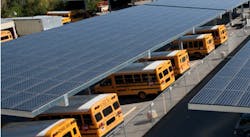ENGIE North America installs Microgrid at Santa Barbara Unified School District
ENGIE North America has installed a microgrid at the Santa Barbara Unified School District in California that includes solar and battery storage capacity.
The on-site distributed energy resources will enable district to effectively tackle power outages and safety shutoffs, which have become a new normal in the state.
The new installation includes 4.2 MW of solar across 14 district locations and six microgrids with 3.8 MWh of battery energy storage. The project is expected to provide $6.47 million of value-added benefits due to the resilience it will offer. It is also expected to offset approximately 90% of the solar array sites' energy use with renewable energy.
"The SBUSD solar microgrids will serve as a model for school districts and other entities anywhere, including how to finance them in a straightforward manner that minimizes upfront costs and risks to the District while also reducing the District's electricity expenditure," said Stefaan Sercu, managing director Energy Solutions Americas at ENGIE. "It's also important to note that communities can now benefit from state and federal funding for projects like these."
With the recently passed federal Inflation Reduction Act, these type of project can make customer eligible for up to a 30 percent tax credit on the cost of solar and storage projects.
"The scope for this program is one of the first for a school district in California," Santa Barbara Unified School District Superintendent Dr. Hilda Maldonado. "This is a community that has been continually impacted by wildfires and subsequent power shutoffs, mudslides and other natural disasters. This project will be critical in the district's efforts to preserve power where it can, as well as provide a fiscally responsible power insurance policy that will ultimately aid the entire community."
About the Author
EnergyTech Staff
Rod Walton is senior editor for EnergyTech.com. He has spent 17 years covering the energy industry as a newspaper and trade journalist.
Walton formerly was energy writer and business editor at the Tulsa World. Later, he spent six years covering the electricity power sector for Pennwell and Clarion Events. He joined Endeavor and EnergyTech in November 2021.
He can be reached at [email protected].
EnergyTech is focused on the mission critical and large-scale energy users and their sustainability and resiliency goals. These include the commercial and industrial sectors, as well as the military, universities, data centers and microgrids.
Many large-scale energy users such as Fortune 500 companies, and mission-critical users such as military bases, universities, healthcare facilities, public safety and data centers, shifting their energy priorities to reach net-zero carbon goals within the coming decades. These include plans for renewable energy power purchase agreements, but also on-site resiliency projects such as microgrids, combined heat and power, rooftop solar, energy storage, digitalization and building efficiency upgrades.
